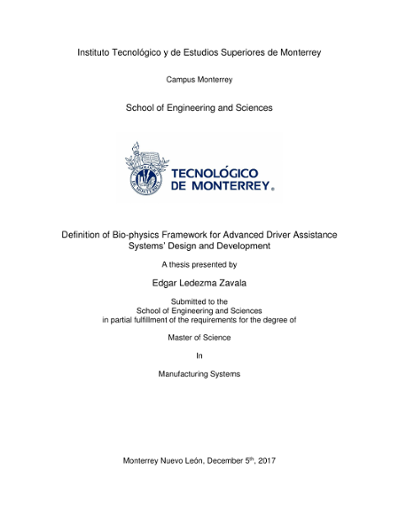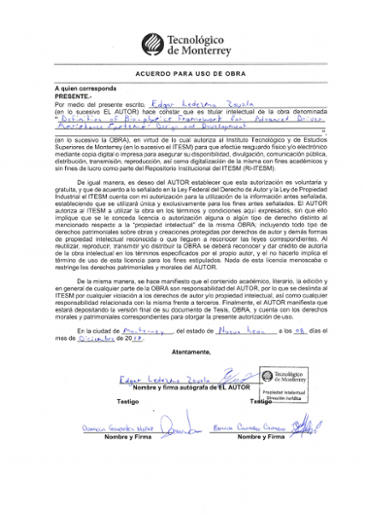| dc.contributor.advisor | Ramírez Mendoza, Ricardo | en_US |
| dc.contributor.author | Ledezma-Zavala, Edgar | en_US |
| dc.date.accessioned | 2018-05-22T19:44:09Z | |
| dc.date.available | 2018-05-22T19:44:09Z | |
| dc.date.issued | 2017-12-05 | |
| dc.identifier.uri | http://hdl.handle.net/11285/629753 | |
| dc.description.abstract | Most recent efforts made in the industry to the path for a full autonomous vehicle have been focusing on the automation of the vehicles’ maneuvers, and the understanding of the surroundings. While a great advance has been achieved, the most advanced implementations of such systems may be only at the scale defined by the US National Highway Traffic Safety Administration as a level 2: “automation of at least two primary control functions”. Such systems require the driver to keep their hands on the steering wheel at all the time. One popular example for this is Tesla Motors´ “Autopilot” feature, which is in fact just a diver-assistant feature rather than a fully autonomous driving system. Given an NHTSA level 2 can still drive on itself by hundreds of miles in the highway, it is easy for driver to misinterpret the real capabilities of current systems and get comfortable on letting the machine take its decisions alone, wandering around visually or mentally, believing they are using a “limited self-diving” NHTSA level 3 of automation, or even a fully autonomous level 4. Current systems have evolved to process a great amount of information coming from the environment, but they may be leaving out the most important character involved in the vehicle: the driver. This project focuses on that forgotten element in the vehicle framework and intends to stablish a robust yet flexible representation for such a concept system as a driving environment, considering the driver itself, the internal mechanics of the vehicle, and external elements such as the driveway, other vehicles or pedestrians and traffic signals both passive and possible active signals with intelligent capabilities of Intelligent Transportations Systems (ITS) | |
| dc.language.iso | eng | en_US |
| dc.rights | Open Access | en_US |
| dc.rights.uri | http://creativecommons.org/licenses/by-nc-sa/4.0/ | * |
| dc.title | Definition of bio-physics framework for advanced driver assistance systems’ design and development | en_US |
| dc.type | Tesis de Maestría | es |
| thesis.degree.grantor | Instituto Tecnológico y de Estudios Superiores de Monterrey | es |
| thesis.degree.level | Master of Science in Manufacturing Systems | en_US |
| dc.contributor.committeemember | Bustamante-Bello, Rogelio | en_US |
| dc.contributor.committeemember | Soto Rodríguez, Rogelio | en_US |
| thesis.degree.discipline | School of Engineering and Sciences | en_US |
| thesis.degree.name | Maestría en Ciencias con especialidad en Sistemas de Manufactura | en_US |
| dc.subject.keyword | ADAS | en_US |
| dc.subject.keyword | ITS | en_US |
| dc.subject.keyword | Active Safety | en_US |
| dc.subject.keyword | Acoustic monitoring | en_US |
| dc.subject.keyword | ADAS Framework | en_US |
| dc.subject.keyword | manufacturing systems | en_US |
| thesis.degree.program | Campus Monterrey | en_US |
| dc.subject.discipline | Ingeniería y Ciencias Aplicadas / Engineering & Applied Sciences | en_US |
| refterms.dateFOA | 2018-05-22T19:44:10Z | |
| html.description.abstract | <html>
<head>
<title></title>
</head>
<body>
<p>Most recent efforts made in the industry to the path for a full autonomous vehicle have been focusing on the automation of the vehicles’ maneuvers, and the understanding of the surroundings. While a great advance has been achieved, the most advanced implementations of such systems may be only at the scale defined by the US National Highway Traffic Safety Administration as a level 2: “automation of at least two primary control functions”. Such systems require the driver to keep their hands on the steering wheel at all the time. One popular example for this is Tesla Motors´ “Autopilot” feature, which is in fact just a diver-assistant feature rather than a fully autonomous driving system. Given an NHTSA level 2 can still drive on itself by hundreds of miles in the highway, it is easy for driver to misinterpret the real capabilities of current systems and get comfortable on letting the machine take its decisions alone, wandering around visually or mentally, believing they are using a “limited self-diving” NHTSA level 3 of automation, or even a fully autonomous level 4. Current systems have evolved to process a great amount of information coming from the environment, but they may be leaving out the most important character involved in the vehicle: the driver. This project focuses on that forgotten element in the vehicle framework and intends to stablish a robust yet flexible representation for such a concept system as a driving environment, considering the driver itself, the internal mechanics of the vehicle, and external elements such as the driveway, other vehicles or pedestrians and traffic signals both passive and possible active signals with intelligent capabilities of Intelligent Transportations Systems (ITS)</p>
</body>
</html> | en_US |


